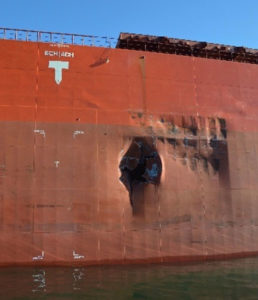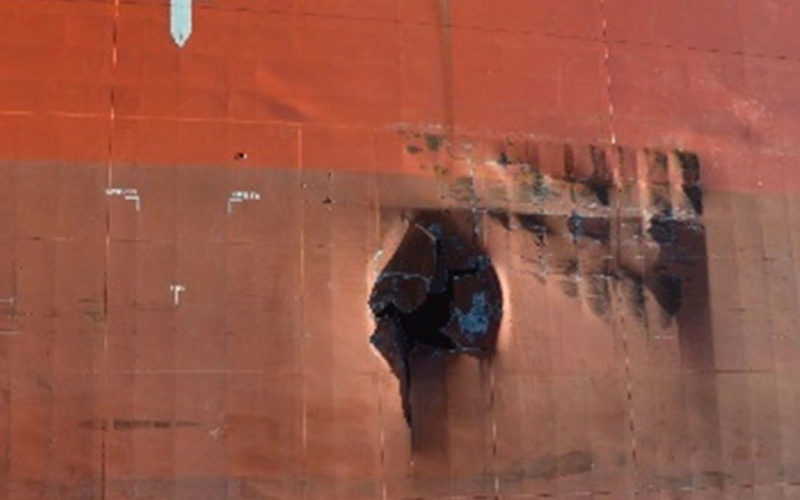
The loaded bulk carrier Caravos Harmony approached an anchorage in Vancouver Harbor, British Columbia, when currents began pushing the vessel to port, directly toward a ship already at anchor.
The pilot aboard Caravos Harmony gave engine and rudder orders to correct its heading. But those engine orders were not effectively carried out by the second mate, who lacked familiarity with the engine control system. Separately, deck crew did not ready the anchors as the pilot requested earlier in the voyage, according to Canada’s Transportation Safety Board (TSB).
Unable to steer out of danger, the 751-foot ship rammed the anchored bulker Pan Acacia on March 17, 2019, at about 0020. The impact holed Pan Acacia’s starboard side and damaged Caravos Harmony’s bow. No injuries or pollution were reported.
TSB investigators identified multiple failures and misunderstandings between the pilot and crew that spiraled after currents began pushing the ship off course.
“The pilot and bridge crew did not share critical information to build a common and accurate team situation awareness, and this impeded timely and effective coordination of actions to safely maneuver the vessel and avoid the striking,” the TSB said in its accident report.
The Marshall Islands-flagged Caravos Harmony, carrying nearly 70,000 tons of corn, departed Tacoma, Wash., late on March 15 for Vancouver Harbor to refuel. A pilot from the British Columbia Coast Pilots boarded at 1655 on March 16 near Victoria, B.C.
The pilot and master conducted a briefing on key details for the entrance into Vancouver Harbor and the planned anchoring maneuver. Soon afterward, the pilot asked for both anchors to be prepared before the ship reached the entrance to the harbor. At about 2320, the pilot asked the master to have both anchors lowered to within 3 feet of the waterline.
The pilot warned the helmsman of strong currents as the ship entered Vancouver Harbor just before midnight. The currents began pushing the ship to port at about 0014, and the captain issued engine and rudder orders to counter them. The ship did not respond as expected.
“At 0015:12, with the main engine in the process of responding to the full-ahead order and the vessel’s speed at around 6 knots, the pilot ordered the master to let go the starboard anchor. Seconds later, the pilot ordered emergency astern,” the report said.
The pilot again ordered the anchor let go, and the master again relayed the message to crew on deck via handheld radio. The pilot issued the emergency astern engine order for a second time because the ship did not respond after the first request.
Crew on deck were unable to release the starboard anchor, which had not been used in nearly three months. The master ordered the port anchor dropped without discussing it with the pilot. That action hastened the ship’s turn to port, putting it on a collision course with the Panama-flagged Pan Acacia.
After further engine difficulties, Caravos Harmony began moving astern at 0018, but by then Pan Acacia was 1,400 feet away and an impact was imminent.
The engine problems, investigators found, stemmed from the way the second mate was moving the engine lever and telegraph unit (LTU). The proper technique for engaging emergency astern propulsion was not followed, the report said. Instead of rapidly moving the LTU handle directly into the emergency astern position, the second mate instead moved the unit through each engine setting along the way, pausing for several seconds between each movement to reduce potential damage to the engine. That series of movements, however, explained the engine’s lack of responsiveness.
“As a consequence of the second officer’s lack of familiarity with the main engine bridge control automation, the engine orders were ineffective and the vessel was slow to respond and continued moving to port,” the report said.
When the starboard anchor would not budge, the master and chief mate discussed the situation in Tagalog, their native language, which the pilot did not understand. The pilot, meanwhile, was unaware that the starboard anchor was stuck or that the master ordered the port anchor released.
The failure involving the starboard anchor would have been known earlier had crew prepared both anchors for deployment as the pilot requested, the report said.
Investigators said the incident highlighted the importance of team situational awareness so that each member correctly understands what is happening. The TSB noted the need for a common working language between the pilot and bridge crew, and said ship personnel also must be familiar with the vessels they operate.
“If familiarization on essential shipboard machinery and equipment is not effective and if necessary instruction manuals and vessel-specific procedures and training are not provided, the crew may not be proficient in the use of the equipment, increasing the risk of accident or injury,” the report said.
The Vancouver Fraser Port Authority has since changed its rules to allow vessels to refuel in English Bay, reducing the number of ships passing into the main harbor through First Narrows.
Caravos Harmony’s operator, Iason Hellenic Shipping Co., has added new training for bridge crew. It also has focused attention on boosting awareness fleetwide about the company’s safety management system.
Attempts to reach the firm, based in Greece, were not successful.

